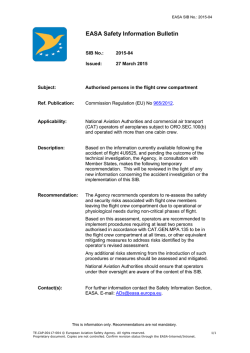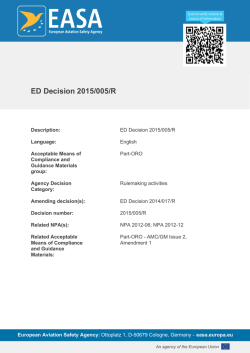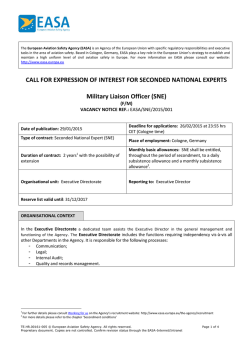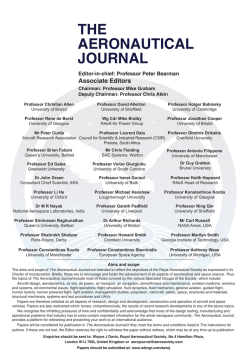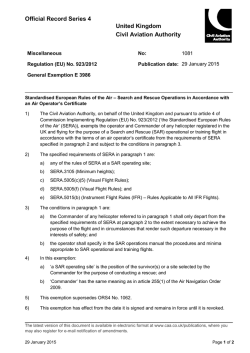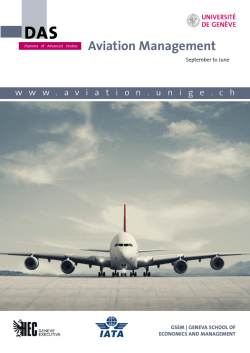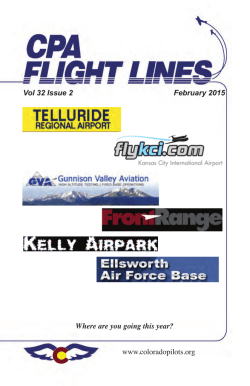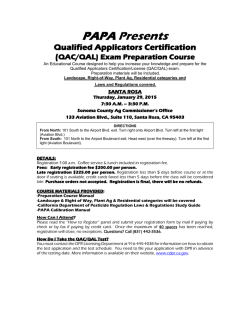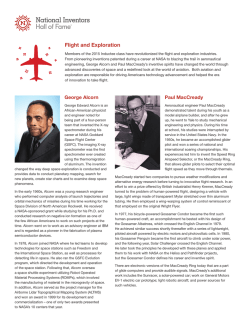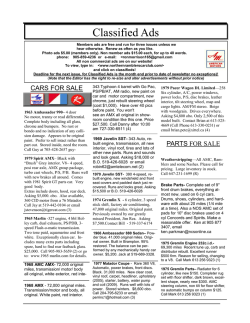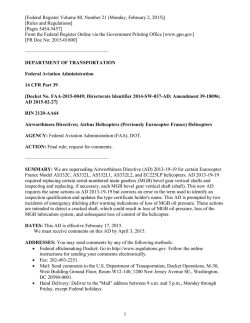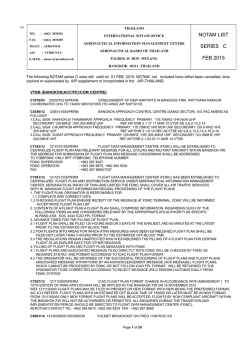
Explanaory Note to ED Decision 2015/003/R - EASA
European Aviation Safety Agency Explanatory Note to Decision 2015/003/R Sterile flight deck procedures ‘AMC and GM to Part-NCC — Amendment 2’ RELATED NPA/CRD 2012-06 — OPINION NO 05/2103 — RMT.0417 (OPS.009(B)) —29.01.2015 EXECUTIVE SUMMARY This Decision addresses a safety issue related to flight deck procedures. The safety recommendations linked to this issue were assessed during the development of this proposal. The specific objective of this Decision is to mitigate the risks linked to errors due to disturbance or distraction of the flight crew during phases of flight where the flight crew must be able to focus on their duties. This Decision introduces procedures for taxiing to enhance runway safety. With the proposed changes, compliance with ICAO is ensured. Applicability Affected Regulations and Decisions: Affected stakeholders: Driver/origin: Reference: Process map Concept Paper: Terms of Reference Rulemaking group: EU Operators RIA type: Technical consultation Safety during NPA drafting: Publication date of the NPA: Safety Recommendations: SPAN-2011-021 and SPAN-2011- Duration of NPA consultation: 22 Review group: Focussed consultation: Publication date of the CRD: Publication date of the Opinion: Decision 2013/021/R (Part-NCC) TE.RPRO.00058-002 © European Aviation Safety Agency. All rights reserved. ISO 9001 certified. Proprietary document. Copies are not controlled. Confirm revision status through the EASA intranet/Internet. An agency of the European Union No 12.9.2011 Yes Light No 11.7.2012 3 months No No 13.2.2013 12.6.2013 Page 1 of 7 European Aviation Safety Agency Explanatory Note to Decision 2015/003/R Table of contents Table of contents 1. Procedural information .................................................................................................................................... 3 1.1. The rule development procedure............................................................................................................3 1.2. Structure of the related documents ........................................................................................................3 2. Explanatory Note.............................................................................................................................................. 4 2.1. Overview of the issues to be addressed ..................................................................................................4 2.2. Objectives ................................................................................................................................................4 2.3. Outcome of the consultation ..................................................................................................................4 2.4. Summary of the Regulatory Impact Assessment (RIA) ............................................................................5 2.5. Overview of the amendments .................................................................................................................6 3. References ........................................................................................................................................................ 7 3.1. Related regulations..................................................................................................................................7 3.2. Affected decisions ...................................................................................................................................7 TE.RPRO.00058-002 © European Aviation Safety Agency. All rights reserved. ISO 9001 certified. Proprietary document. Copies are not controlled. Confirm revision status through the EASA intranet/Internet. An agency of the European Union Page 2 of 7 European Aviation Safety Agency Explanatory Note to Decision 2015/003/R 1. Procedural information 1. Procedural information 1.1. The rule development procedure The European Aviation Safety Agency (hereinafter referred to as the ‘Agency’) developed this Decision in line with Regulation (EC) No 216/20081 (hereinafter referred to as the ‘Basic Regulation’) and the Rulemaking Procedure2. This rulemaking activity is included in the Agency’s 4-year Rulemaking Programme under RMT.0417 (OPS.009(b))3. The scope and timescale of the task were defined in the related Terms of Reference (see process map on the title page). The text of this Decision has been developed by the Agency supported by the Rulemaking Group RMT.0416 (OPS.009(a)) and RMT.0417 (OPS.009(b)). All interested parties were consulted through the Notice of Proposed Amendment (NPA) 2012-064. 134 comments were received from interested parties, including industry and National Aviation Authorities. The Agency has addressed and responded to the comments received on the NPA. The comments received and the Agency’s responses are documented in the Comment-Response Document (CRD) 2012-065. The final text of this Decision with the Acceptable Means of Compliance (AMC) and Guidance Material (GM) has been developed by the Agency. The process map on the title page summarises the major milestones of this rulemaking activity. 1.2. Structure of the related documents Chapter 1 contains the procedural information related to this task. Chapter 2 explains the core technical content. The text of the AMC/GM is annexed to the ED Decision. 1 2 3 4 5 Regulation (EC) No 216/2008 of the European Parliament and of the Council of 20 February 2008 on common rules in the field of civil aviation and establishing a European Aviation Safety Agency, and repealing Council Directive 91/670/EEC, Regulation (EC) No 1592/2002 and Directive 2004/36/EC (OJ L 79, 19.3.2008, p. 1). The Agency is bound to follow a structured rulemaking process as required by Article 52(1) of the Basic Regulation. Such process has been adopted by the Agency’s Management Board and is referred to as the ‘Rulemaking Procedure’. See Management Board Decision concerning the procedure to be applied by the Agency for the issuing of opinions, certification specifications and guidance material (Rulemaking Procedure), EASA MB Decision No 01-2012. Rulemaking Programme available at http://easa.europa.eu/rulemaking/annual-programme-and-planning.php. In accordance with Article 52 of the Basic Regulation and Articles 5(3) and 6 of the Rulemaking Procedure; NPA available at http://easa.europa.eu/rulemaking/r-archives.php. CRD available at http://easa.europa.eu/rulemaking/r-archives.php. TE.RPRO.00058-002 © European Aviation Safety Agency. All rights reserved. ISO 9001 certified. Proprietary document. Copies are not controlled. Confirm revision status through the EASA intranet/Internet. An agency of the European Union Page 3 of 7 European Aviation Safety Agency Explanatory Note to Decision 2015/003/R 2. Explanatory Note 2. Explanatory Note 2.1. Overview of the issues to be addressed The issues to be addressed are described in detail in NPA 2012-06 and also in Opinion No 05/20126. Therefore, only a brief overview is provided in this Decision. Over the years, it has been identified that an accident or an incident may occur when the flight crew divert their attention from the task at hand and get occupied with activities not directly related to the current phase of the flight. Such activities are extraneous conversations, cabin crew calls on nonessential matters, non-pertinent radio calls, public address announcements, etc. Clearly, the chance of error increases when the flight crew are disturbed or distracted from their main responsibilities. Consequences that could result from such a disturbance or distraction include altitude deviations, course deviations, runway transgressions, and take-offs or landings without clearance. In light of the safety risk, the flight crew must be able to focus on their duties without being disturbed or distracted by non-flight related matters, whenever necessary, during movement of the aircraft. This holds especially for safety-critical phases of the flight. Implementing Rules (Commission Regulation (EU) No 965/2012) and associated AMC/GM for air operations are in force. However, even with these measures, the following elements are not included in the regulatory framework: a. the concept of a sterile flight deck; b. the taxi phase of aeroplanes as a safety-critical activity; and c. procedures for taxiing to enhance runway safety. The need to consider these elements has been briefly described above and has been explained in detail in NPA 2012-06. The Agency summarised the present rulemaking tasks under the title ‘Sterile flight deck procedures’. This Decision introduces procedures for taxiing to enhance runway safety by inserting AMC/GM in Annex VI (Part-NCC). Other Decisions, related to the subject under the title ‘Sterile flight deck procedures’ introduce AMC/GM in Annex I (Definitions), Annex III (Part-ORO), Annex IV (Part-CAT), Annex VII (Part-NCO) and Annex VIII (Part-SPO). 2.2. Objectives The overall objectives of the EASA system are defined in Article 2 of the Basic Regulation. This Decision will contribute to the achievement of the overall objectives by addressing the issues outlined in Paragraph 2.1. The specific objective of this Decision is, therefore, to mitigate the safety risk by introducing procedures for taxiing. 2.3. Outcome of the consultation As mentioned above, the Agency has received 134 comments on NPA 2012-06. A detailed description of the changes resulting from these comments is provided in CRD 2012-06. On CRD 2012-06 the Agency received 5 reactions in total. 1 reaction is related to Annex VI (Part-NCC) as follows: 6 Opinion available at http://easa.europa.eu/agency-measures/opinions.php. TE.RPRO.00058-002 © European Aviation Safety Agency. All rights reserved. ISO 9001 certified. Proprietary document. Copies are not controlled. Confirm revision status through the EASA intranet/Internet. An agency of the European Union Page 4 of 7 European Aviation Safety Agency Explanatory Note to Decision 2015/003/R 2. Explanatory Note One commentator pointed out that several provisions of the proposed subparagraph (d) of AMC1 NCC.GEN.119 are not applicable to single-pilot operations. The commentator proposed to mention this fact in the AMC. The Agency accepted the commentator’s proposal concerning two subparagraphs and, therefore, inserted the new subparagraph (e) in AMC1 NCC.GEN.119 as follows: ‘(e) Subparagraphs (d)(2) and (d)(7) are not applicable to single-pilot operations’. In addition, following further internal discussions, the Agency decided to change AMC1 NCC.GEN.119 as follows: — Concerning the use of lights during taxiing, CRD 2012-06 contained the following text (see subparagraph (c)): ‘(c) use of lights as follows: (1) strobe lights, where fitted, when entering or crossing a runway (active or inactive); and (2) landing lights for take-off;’. The specific information of (1) and (2) is deleted to avoid confusion, but the phrase ‘use of lights’ as a general procedure for taxiing is kept. — 2.4. In subparagraph (d), the additional statement ‘The following list of typical items should be adapted by the operator to take into account its operational environment’ is inserted. Summary of the Regulatory Impact Assessment (RIA) The options identified in the Regulatory Impact Assessment (RIA)7 were as follows: a. Option 0: Baseline option (no change; risks remain as outlined in the issue analysis). b. Option 1: No rulemaking, but encouraging operators to establish procedures, as needed. c. Option 2: Rulemaking for sterile flight deck procedures for all critical phases of flight, for taxiing of aeroplanes and for flight below 10 000 feet, except cruise flight, by amending Implementing Rules, AMC, and GM, as appropriate. Taxiing of aeroplanes is treated as a safety-critical activity, but it is not defined as a critical phase of flight. d. Option 3: Rulemaking for sterile flight deck procedures for all critical phases of flight and for flight below 10 000 feet, except cruise flight, by amending Implementing Rules, AMC, and GM, as appropriate. Taxiing of aeroplanes is defined as a critical phase of flight. The most important impacts identified in the RIA for each option are the safety, the economic and the harmonisation impact. In the RIA it was concluded that Option 2 is the preferred option. The main reason is that this option leads to a high reduction of the safety risk with a reasonable impact on costs. The costs of Option 3 are expected to be significantly higher than the ones of Option 2 due to the additional burden of defining taxiing as a critical phase of flight, while the reduction of the safety risk is 7 For details of the RIA, see Section C of NPA 2012-06. TE.RPRO.00058-002 © European Aviation Safety Agency. All rights reserved. ISO 9001 certified. Proprietary document. Copies are not controlled. Confirm revision status through the EASA intranet/Internet. An agency of the European Union Page 5 of 7 European Aviation Safety Agency Explanatory Note to Decision 2015/003/R 2. Explanatory Note only slightly lower. In addition, Option 2, in contrast to Options 0 and 1, does not deviate from international acknowledged manuals and action plans. It should be noted, however, that Option 2 means no full harmonisation with the relevant U.S. Regulation. 2.5. Overview of the amendments Following the reaction described above, and compared to the proposed AMC/GM in CRD 2012-06, the Agency modified the AMC/GM of Annex VI (Part-NCC) as described in Paragraph 2.3. In addition, editorial changes, not only related to the substantial amendments to this Decision, have been made. The final text is provided in a separate Annex to this Decision. TE.RPRO.00058-002 © European Aviation Safety Agency. All rights reserved. ISO 9001 certified. Proprietary document. Copies are not controlled. Confirm revision status through the EASA intranet/Internet. An agency of the European Union Page 6 of 7 European Aviation Safety Agency Explanatory Note to Decision 2015/003/R 3. References 3. References 3.1. Related regulations Commission Regulation (EU) No 965/2012 of 5 October 2012 laying down technical requirements and administrative procedures related to air operations pursuant to Regulation (EC) No 216/2008 of the European Parliament and of the Council (OJ L 296, 25.10.2012, p. 1). 3.2. Affected decisions Decision 2013/021/R of the Executive Director of the Agency of 23 August 2013 on adopting Acceptable Means of Compliance and Guidance Material for non-commercial operations with complex motor-powered aircraft (Part-NCC). Available at http://easa.europa.eu/agency-measures/agencydecisions.php. TE.RPRO.00058-002 © European Aviation Safety Agency. All rights reserved. ISO 9001 certified. Proprietary document. Copies are not controlled. Confirm revision status through the EASA intranet/Internet. An agency of the European Union Page 7 of 7
© Copyright 2025
